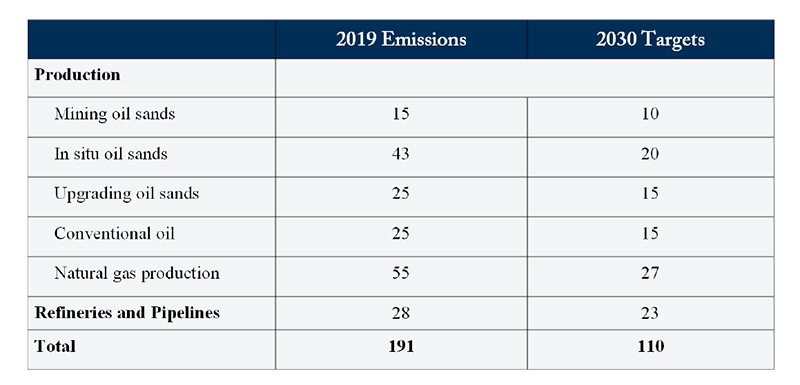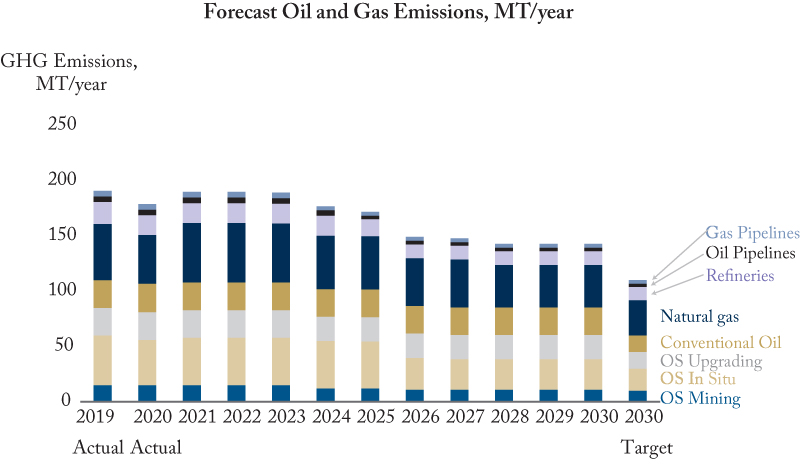To: The Hon. Steven Guilbeault, Minister of Environment and Climate Change
From: Brian Livingston
Date: December 14, 2022
Re: Counting Carbon II: A Reality Check on Our Emission Reduction Plan
The federal government’s ambitious Emissions Reduction Plan (ERP) sets out targets for seven economic sectors as it aims to cut 2030 emissions by 42 percent from 2019 levels. But the ERP is merely a plan to have a plan. It contains no specific steps to meet its targets, or any mechanism for measuring the progress towards such targets on a year-by-year basis. This special series of Intelligence Memos introduces seven forecast models tailored to each sector that provide a realistic assessment of what’s needed to meet Ottawa’s goals, and each sector’s key variables to emission reductions. These will be used to predict annual emissions from each sector from 2020 to 2030. The charts and spreadsheets underlying this work can be found here.
Yesterday, transportation. Today: Oil and gas.
The oil and gas sector produces roughly one quarter of Canada’s greenhouse gas (GHG) emissions and is broken down, as follows, along with projected reductions, in the table below:

The largest portion of these reductions will have to come from the use of cogeneration, carbon capture, utilization and storage (CCUS), Direct Air Capture (DAC), renewable fuels, renewable power, reducing methane leaks, replacing natural gas with another energy source such as Small Modular Reactors to generate steam and the use of solvent as opposed to steam for in situ production.
Ten companies – Suncor, Cenovus, CNRL, Imperial Oil, ConocoPhillips, MEG Energy, Shell Canada, Irving Oil, Enbridge and TC Resources – accounted for about 60 percent of GHG emissions in 2019, with the remainder splintered over many smaller firms.
The top 10 have announced various targets for emission reductions by 2030. Six belong to the Pathways Alliance, a consortium that has an announced a reduction target of 22 MT by 2030. Some are absolute amounts (Suncor targets a reduction of 10 MT by 2030), while others focus on a reduction in emissions intensity in 2030 by either 30 percent (Imperial Oil, MEG Energy, TC Energy, Irving Oil) or 35 percent (Cenovus, Enbridge.)
However, as recently enumerated by the Pembina Institute, there have been few actual announcements from any of these companies about precise steps or investments they plan in specific facilities.
Even so, the model on the C.D. Howe Institute website assumes that the top 10 firms will meet the various targets they have announced. Specifically, the six companies in the Pathways Alliance are assumed to reach the 22 MT target.
Based on these assumptions, the model forecasts an emissions reduction by 2030 for the top 10 oil and gas companies of about 33 MT, or a 28-percent reduction from 2019 emissions. The remaining companies are assumed to reduce emissions by 15 MT, or 20 percent.
Combining these two numbers gives a 2030 emissions forecast of 143 MT, which is still short of Ottawa’s 110-MT target.
According to the companies, their planned reductions will come from cogeneration (6 MT), carbon capture and underground storage (16 MT), renewable fuels (4 MT), renewable power (3 MT), methane emission reduction (17 MT) and other (2 MT). Notably missing from any company plan were investments in DAC or Small Modular Reactors.
So how to hit the 110 MT target?
The most draconian solution would be a production shut-in order from the federal government. This federal action would provoke an outraged reaction (both political and legal) from Alberta and other producing provinces. A better solution would be for governments (particularly the federal government) to act as a first mover in DAC facilities. They could do this by introducing a legal regime that would offer a guaranteed price for each tonne of emissions removed by a DAC facility.

Brian Livingston is Executive Fellow at the School of Public Policy at the University of Calgary.
Counting Carbon is a four part series analyzing Canada's Emission Reduction Plan.
To read part one on Transportation click here
To read part three on Buildings click here
To send a comment or leave feedback, email us at blog@cdhowe.org.
The views expressed here are those of the author. The C.D. Howe Institute does not take corporate positions on policy matters.





